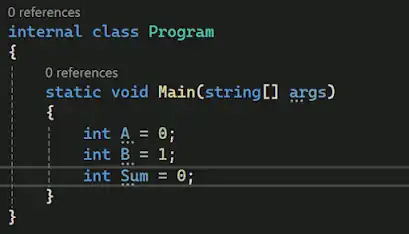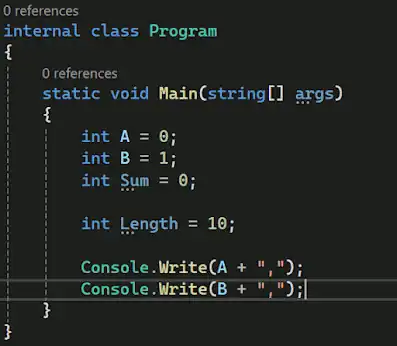In this blog, you can learn and understand the logic behind the Fibonacci series. Don’t worry, I won’t delve into its history, as that’s not the focus here. However, an interviewer may ask you to write code to generate the sequence up to the Nth Fibonacci number. what to explore Pyramid and Pattern program ?
Table of Contents
Fibonacci series logic
The logic behind this number sequence is to generate the next number by adding the two previous numbers. The Fibonacci sequence starts with 0, 1, then the sum of these numbers, which would be 1, then 2, then 3, and so on, continuing to sum the previous two numbers.
Let’s clarify this further. Suppose you want to find the Fibonacci number of N. Then, your formula would be N = (N-1) + (N-2). To make it clearer, let’s dive into the programming part and see how you would write this type of logic.
Implementing the Fibonacci Series in Practical Code
To begin, you need to create three variables. In this case, I’m using the int data type and creating three variables named A, B, and Sum.

Next, you need to create a new variable called Length. This variable will determine how many numbers you want to generate in the Fibonacci series. I’m using the int data type for this variable. Print variables A and B to display the initial two indices of the Fibonacci series, which are 0 and 1.

Now, create a for loop starting from 0 and ending at the value stored in the Length variable you created. Inside the loop, calculate the sum by adding A and B. Then, display the value of Sum. It’s crucial to note that you must display the value of Sum after assigning it the value of A + B; otherwise, you won’t obtain the correct Fibonacci sequence. After displaying Sum, assign the value of B to A and the value of Sum to B.

Fibonacci series program
internal class Program
{
static void Main(string[] args)
{
int A = 0;
int B = 1;
int Sum = 0;
int Length = 10;
Console.Write(A + ",");
Console.Write(B + ",");
for (int i = 0; i < Length; i++)
{
Sum = A + B;
Console.Write(Sum+",");
A = B;
B = Sum;
}
}
}Summarizing the Fibonacci Sequence
In the blog post, we explore the logic behind the Fibonacci series, focusing on its practical application rather than its historical background. The key idea is to generate the next number in the sequence by summing the two preceding numbers. To illustrate this, we create variables A, B, and Sum, initialized as 0, 1, and 0 respectively. Another variable, Length, determines the number of Fibonacci numbers to generate. We then print the initial values of A and B.
Subsequently, we use a for loop to iterate from 0 to Length. Inside the loop, we update Sum by adding A and B, print Sum to display the next number in the sequence, and then update A with the value of B and B with the value of Sum. This process ensures the correct generation of the Fibonacci sequence or fibonacci parallel programming.
